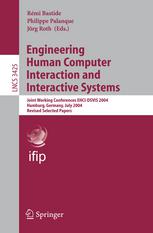

Most ebook files are in PDF format, so you can easily read them using various software such as Foxit Reader or directly on the Google Chrome browser.
Some ebook files are released by publishers in other formats such as .awz, .mobi, .epub, .fb2, etc. You may need to install specific software to read these formats on mobile/PC, such as Calibre.
Please read the tutorial at this link: https://ebookbell.com/faq
We offer FREE conversion to the popular formats you request; however, this may take some time. Therefore, right after payment, please email us, and we will try to provide the service as quickly as possible.
For some exceptional file formats or broken links (if any), please refrain from opening any disputes. Instead, email us first, and we will try to assist within a maximum of 6 hours.
EbookBell Team

5.0
40 reviewsAs its name suggests, the EHCI-DSVIS conference has been a special event, merging two different, although overlapping, research communities: EHCI (Engineering for Human-Computer Interaction) is a conference organized by the IFIP 2.7/13.4 working group, started in 1974 and held every three years since 1989. The group’s activity is the scientific investigation of the relationships among the human factors in computing and software engineering. DSVIS (Design, Specification and Verification of Interactive Systems) is an annual conference started in 1994, and dedicated to the use of formal methods for the design of interactive systems. Of course these two research domains have a lot in common, and are informed by each other’s results. The year 2004 was a good opportunity to bring closer these two research communities for an event, the 11th edition of DSVIS and the 9th edition of EHCI. EHCI-DSVIS was set up as a working conference bringing together researchers and practitioners interested in strengthening the scientific foundations of user interface design, specification and verification, and in examining the relationships between software engineering and human-computer interaction. The call for papers attracted a lot of attention, and we received a record number of submissions: out of the 65 submissions, 23 full papers were accepted, which gives an acceptance rate of approximately 34%. Three short papers were also included. The contributions were categorized in 8 chapters: Chapter 1 (Usability and Software Architecture) contains three contributions which advance the state of the art in usability approaches for modern software engineering.